Calculus 45S Slides April 24, 2008
- 1. st and nd Derivative Tests Wildwood 2007 Set by flickr user always13
- 2. The height of a ball (in feet) t seconds after it is thrown is given by: it's (upward) velocity at time t is: (a) From what height was the ball thrown? (b) What is the ball's initial velocity? Was it thrown up or down? How can you tell? (c) Was the ball's height increasing or decreasing at time t = 2? (d) At what time did the ball reach it's maximum height? How high was it then? (e) How long was the ball in the air?
- 3. The graph of a function ƒ is shown below. Rank the values of ƒ'(-3), ƒ'(-2), ƒ'(0), ƒ'(1) and ƒ'(4) in increasing order.

